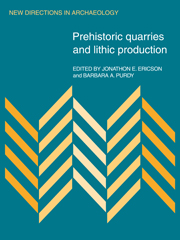Book contents
- Frontmatter
- Contents
- List of contributors
- Dedication
- Part 1 Introduction
- Part 2 Procurement, production, and exchange
- Part 3 Technology and techniques
- 10 Jigsaw: reconstructive lithic technology
- 11 Quarry studies: technological and chronological significance
- 12 Characterization of selected soapstone sources in southern New England
- 13 Reconstructing Corbiac: the context of manufacturing at an Upper Paleolithic quarry
- Index
12 - Characterization of selected soapstone sources in southern New England
Published online by Cambridge University Press: 04 August 2010
- Frontmatter
- Contents
- List of contributors
- Dedication
- Part 1 Introduction
- Part 2 Procurement, production, and exchange
- Part 3 Technology and techniques
- 10 Jigsaw: reconstructive lithic technology
- 11 Quarry studies: technological and chronological significance
- 12 Characterization of selected soapstone sources in southern New England
- 13 Reconstructing Corbiac: the context of manufacturing at an Upper Paleolithic quarry
- Index
Summary
Color, texture, mineralogy, thin-section petrography, and atomic-absorption spectrophotometry are used to characterize soapstone samples from several prehistoric quarry sites in Connecticut, Rhode Island, and Massachusetts. Using the petrographic profiles generated by these analyses, the authors attempt to attribute a number of soapstone artifacts from archaeological contexts to their respective quarry source. The encouraging results suggest that a combination of major-element analyses and observable characteristics may serve, in at least some cases, to differentiate adequately soapstone sources and their derivative artifacts.
Archaeologists recently have come to recognize geoarchaeology as an area of productive endeavor (Butzer 1971; Shackley 1975; Davidson & Shackley 1975; Gladfelter 1977; Vita-Finzi 1978). Straddling the flexible boundaries between geology and archaeology, this new research has contributed to at least three major concerns. One, geoarchaeological dating, includes the application of archaeologically derived chronologies to recent geological strata and features (Haynes 1968; Butzer 1974); dating of archaeological sites by geological means also has been attempted with some success (Zeuner 1958; Giddings 1966). A second concern has been archaeologists' explicit recognition of the applicability of geomorphological principles in the formation of archaeological landscapes (Bryan 1926; Butzer 1971; Hassan 1978; Turnbaugh 1977, 1978; Vita-Finzi 1978). This focus has highlighted new aspects of ancient humans' interrelationship with the environment, including their impact upon it. Third, geochemistry has proven to be a fruitful technique for research in archaeological contexts, particularly with regard to discussions about prehistoric lithic exploitation, trade, and technology.
- Type
- Chapter
- Information
- Prehistoric Quarries and Lithic Production , pp. 129 - 138Publisher: Cambridge University PressPrint publication year: 1984
- 3
- Cited by



